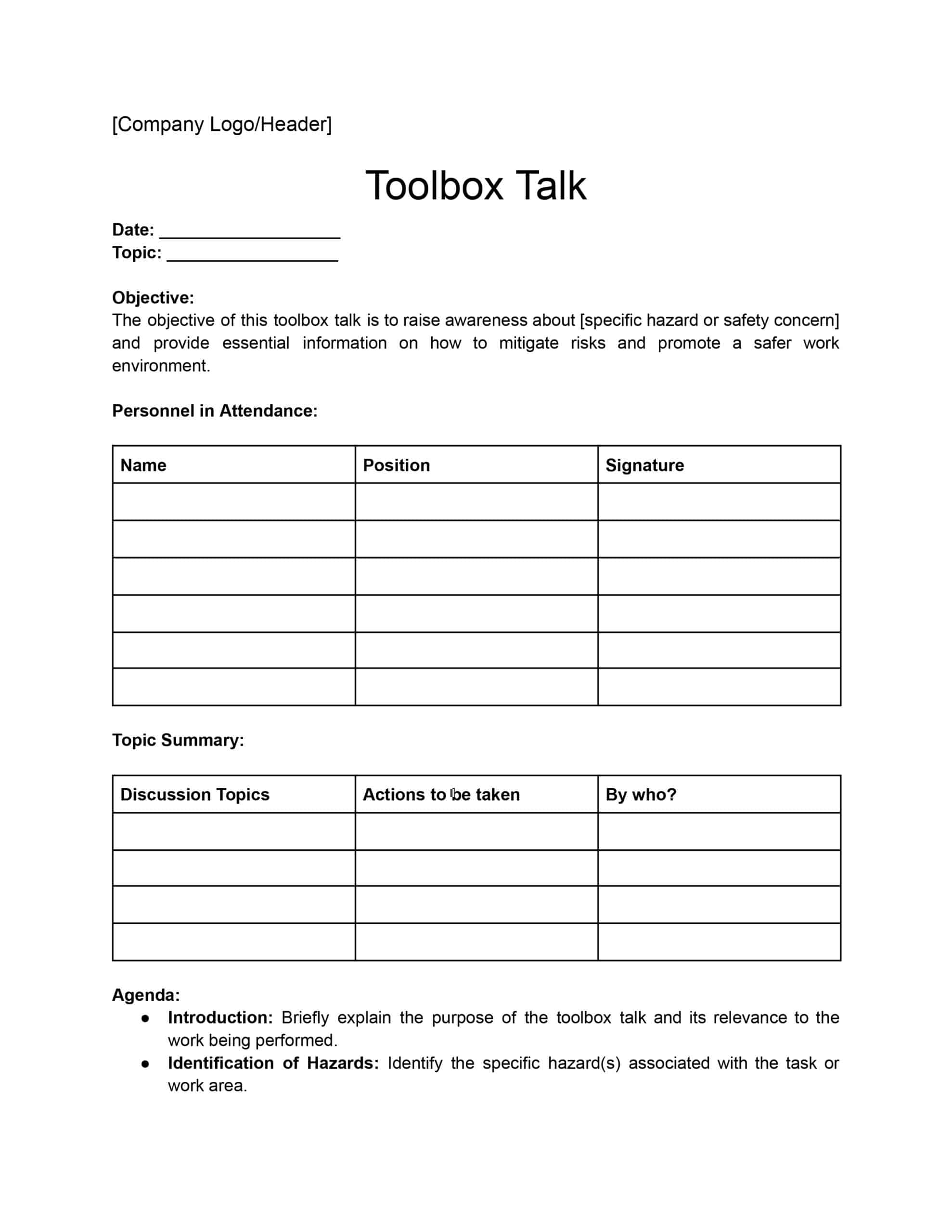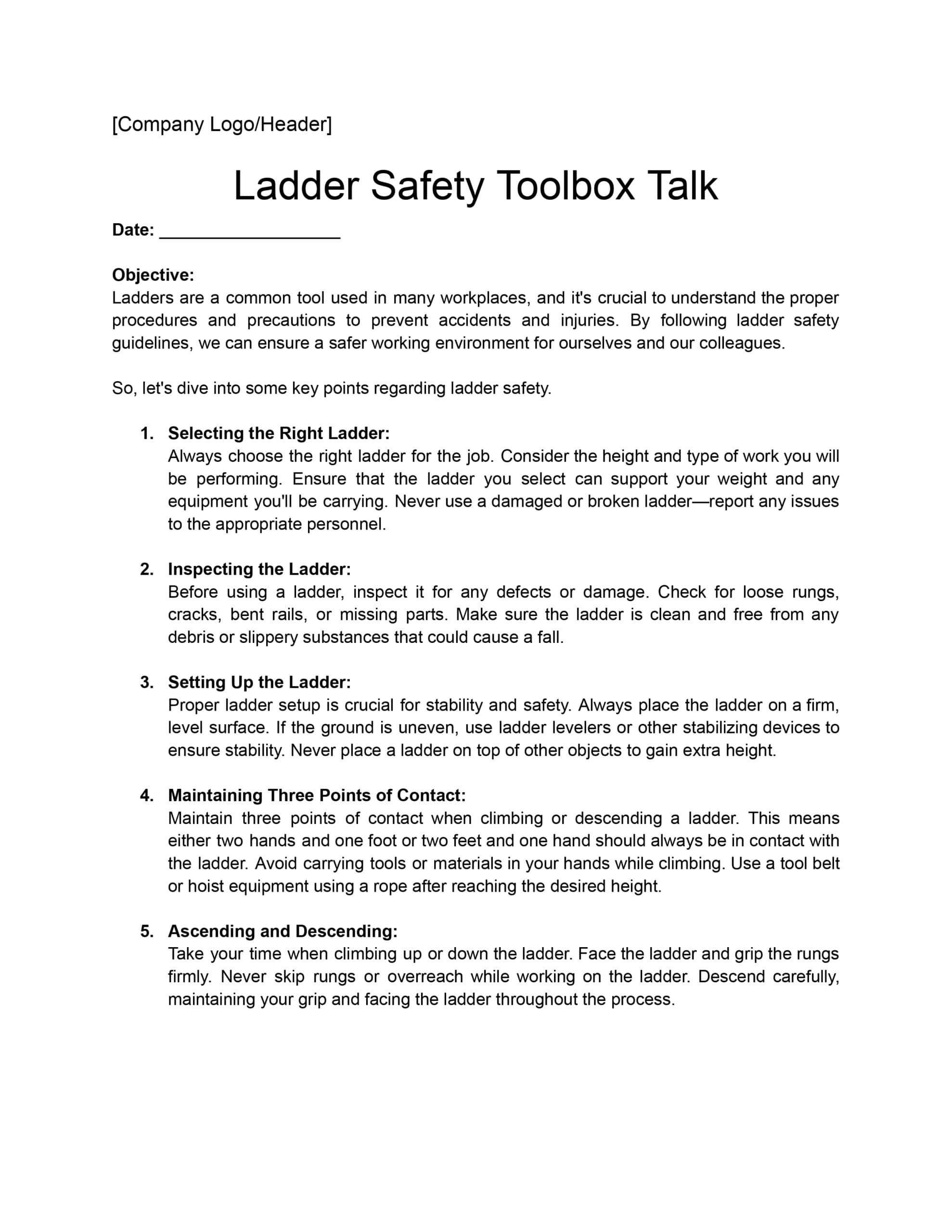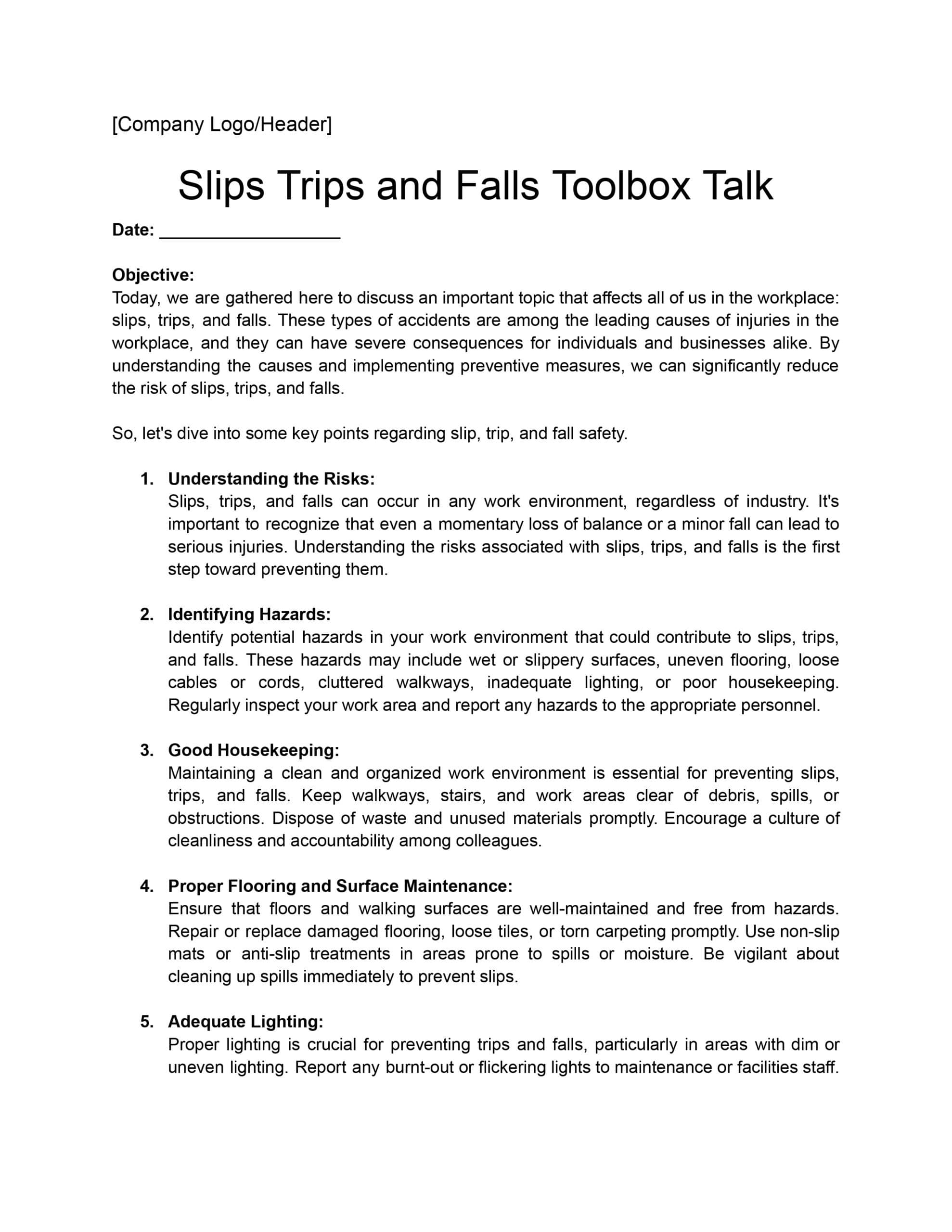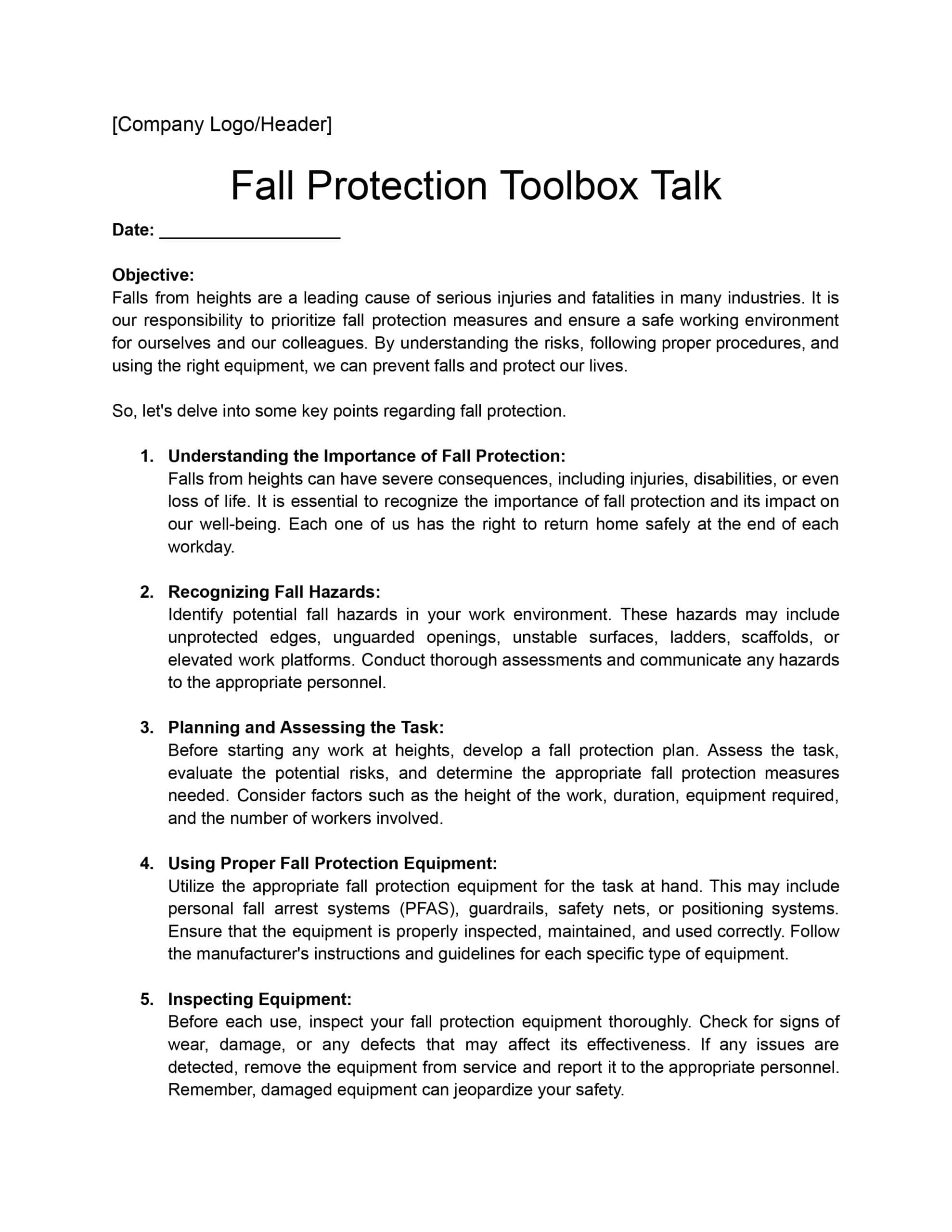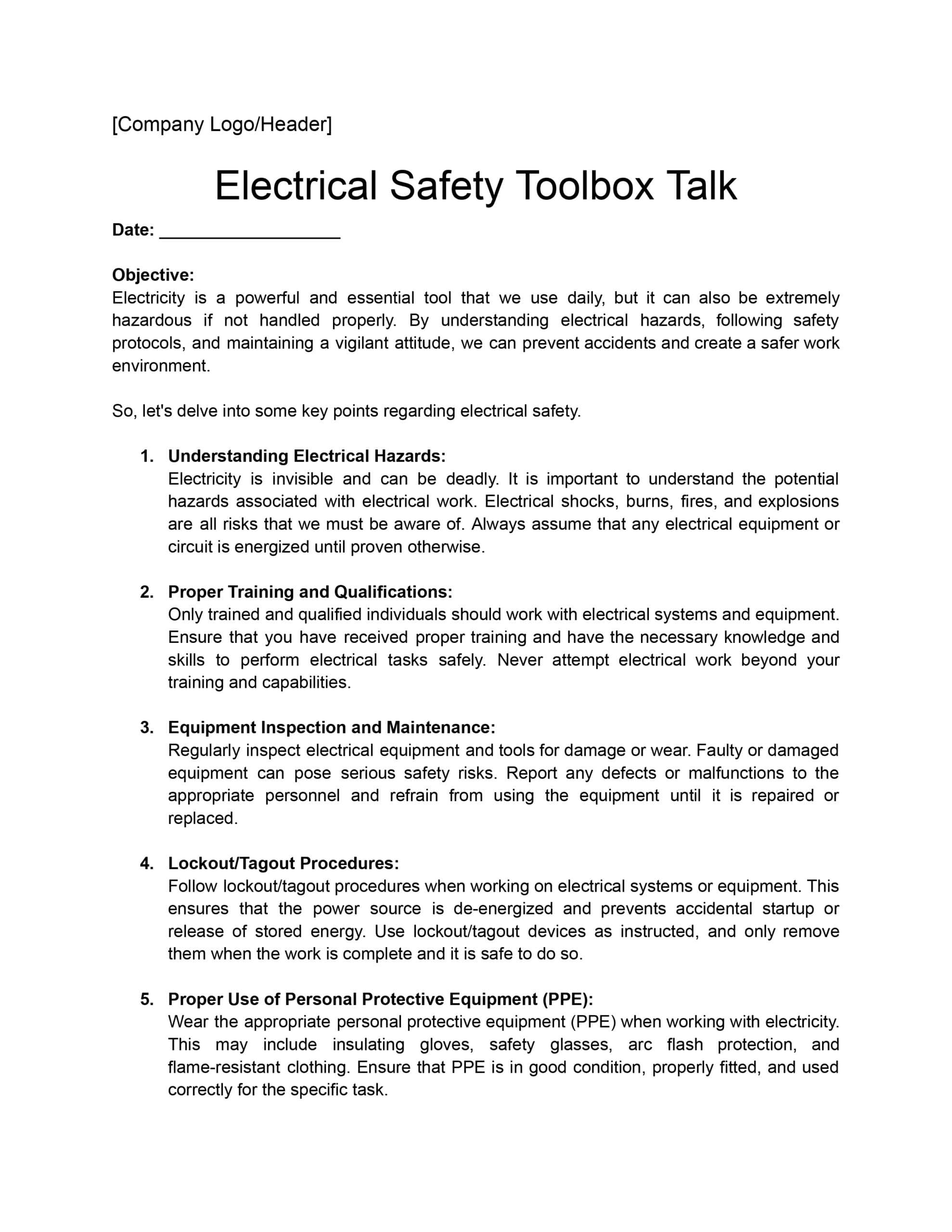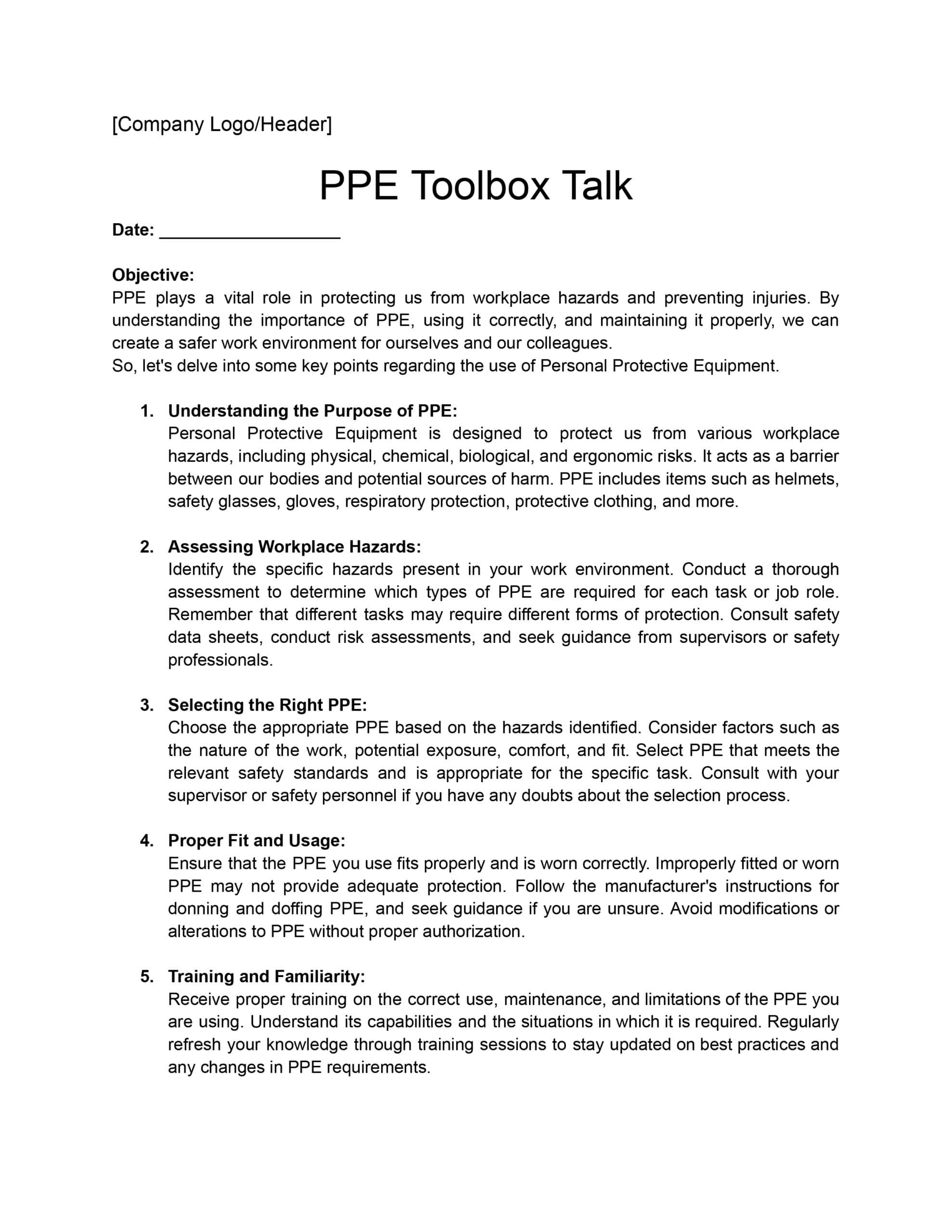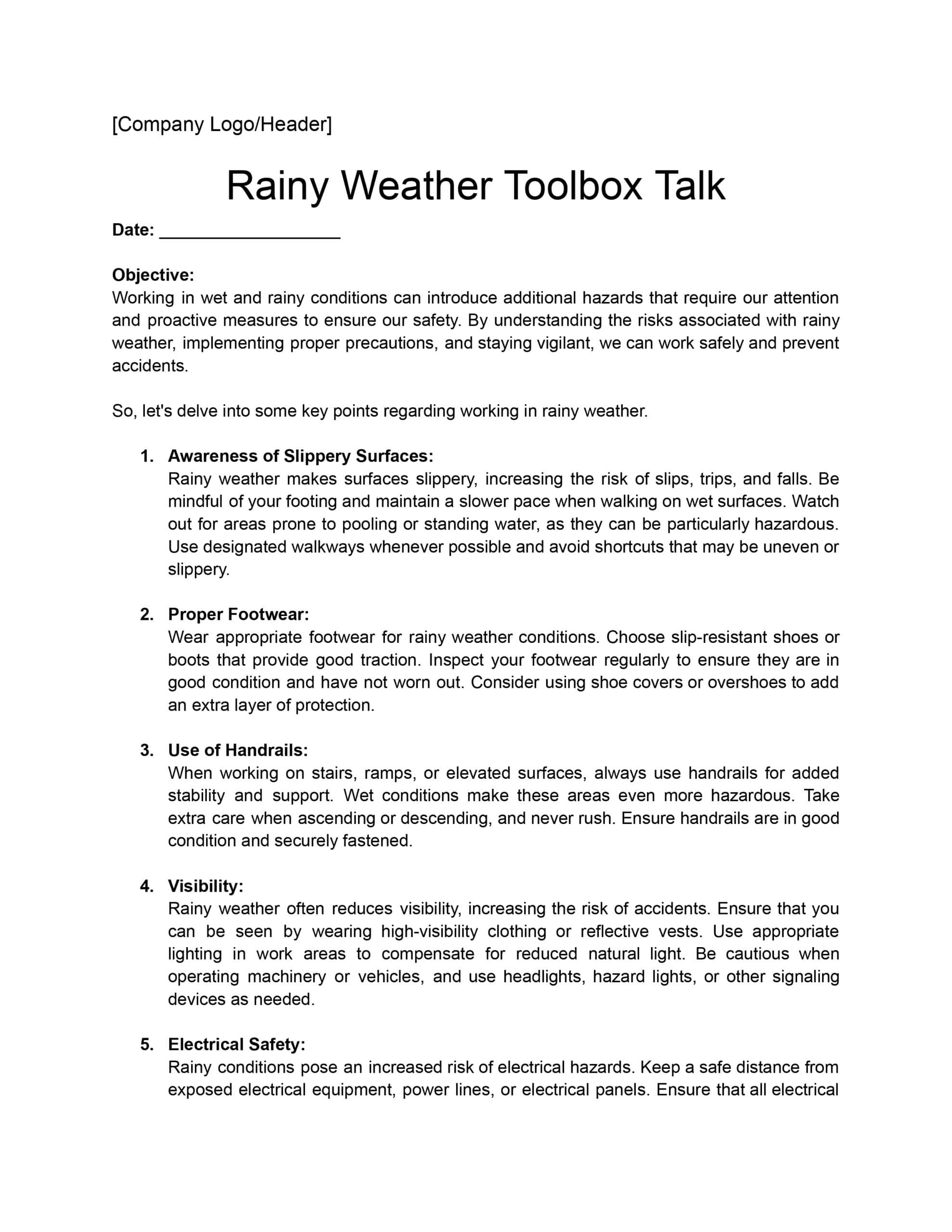Toolbox talks are a big part of keeping construction sites safe. According to a 2020 report, companies that hold daily safety talks reduce accidents by 82%. Despite this, many teams skip them because they take time to prepare or aren’t sure where to start.
That’s where toolbox talk templates come in. These templates make it easy to plan and lead quick, effective safety talks.
So we have prepared some templates for you, including
- Ladder Safety Toolbox Talk
- Hand Safety Toolbox Talk
- Slips Trips And Falls Toolbox Talk
- Fall Protection Toolbox Talk
- Electrical Safety Toolbox Talk
- PPE Toolbox Talk
- Rainy Weather Toolbox Talk
We give you insights into why they’re a must-have for any crew and of course, a guide on how are how to use them. We’ll also cover tips to make them work better for you and common mistakes to avoid.
With the right tools, you can save time, stay organized, and keep your team safe.
Download your toolbox talk templates today and make workplace safety a top priority!
Templates by Type
- Toolbox Talk Template
- Ladder Safety Toolbox Talk
- Hand Safety Toolbox Talk
- Slips, Trips, and Falls Toolbox Talk
- Fall Protection Toolbox Talk
- Electrical Safety Toolbox Talk
- PPE Toolbox Talk
- Rainy Weather Toolbox Talk
Toolbox Talk Template
This template is designed to facilitate structured safety discussions across various topics. It helps supervisors address workplace hazards effectively while promoting safety awareness.
By using this template, managers can ensure each talk is consistent, relevant, and impactful, keeping safety a top priority.
How to Get These Templates:
-
PDF
- Click the link
- Click the Download icon in the upper right
-
Microsoft Word (.DOCX) and Excel (.XLSX)
- Click the link
- Open the File menu in the upper right
- Click Download
- Select .docx (Word) or .xlsx (Excel)
-
Google Docs and Sheets:
- Click the link
- You must be logged into a Google Drive account
- Open the File menu in the upper right
- Click Make a Copy
How to Use These Templates:
- Focused Topics: Pre-designed sections for discussions on hazards like PPE, slips and falls, or equipment use.
- Clear Guidelines: Steps for addressing risks, best practices, and emergency responses.
- Customization Options: Adaptable content for specific industries or job sites.
Ladder Safety Toolbox Talk
This template is designed to help teams understand the risks and safe practices associated with ladder use. It’s perfect for reinforcing safety protocols before tasks that involve ladder work.
With a clear structure, this template ensures every discussion addresses critical points, reducing the risk of ladder-related accidents.
How to Get These Templates:
-
PDF
- Click the link
- Click the Download icon in the upper right
-
Microsoft Word (.DOCX) and Excel (.XLSX)
- Click the link
- Open the File menu in the upper right
- Click Download
- Select .docx (Word) or .xlsx (Excel)
-
Google Docs and Sheets:
- Click the link
- You must be logged into a Google Drive account
- Open the File menu in the upper right
- Click Make a Copy
How to Use These Templates:
- Key Hazards: Identify risks like improper use, unstable surfaces, and overreaching.
- Best Practices: Guidelines for inspecting ladders, proper positioning, and safe usage.
- Discussion Points: Emphasize the importance of maintaining three points of contact and proper weight limits.
Hand Safety Toolbox Talk
Protecting workers’ hands is crucial in any workplace. This template focuses on raising awareness about potential hazards and teaching preventive measures to keep hands safe during tasks.
Use this template to engage teams in meaningful discussions about hand safety and ensure they are equipped to minimize injuries.
How to Get These Templates:
-
PDF
- Click the link
- Click the Download icon in the upper right
-
Microsoft Word (.DOCX) and Excel (.XLSX)
- Click the link
- Open the File menu in the upper right
- Click Download
- Select .docx (Word) or .xlsx (Excel)
-
Google Docs and Sheets:
- Click the link
- You must be logged into a Google Drive account
- Open the File menu in the upper right
- Click Make a Copy
How to Use These Templates:
- Common Risks: Discuss hazards such as cuts, crush injuries, and chemical exposure.
- Preventative Measures: Steps for wearing proper gloves, using tools correctly, and maintaining awareness.
- Emergency Response: Actions to take in case of hand injuries, including first aid and reporting.
Click to download template
Slips, Trips, and Falls Toolbox Talk
This template helps teams identify and mitigate risks associated with slips, trips, and falls. It’s suitable for workplaces with high foot traffic or uneven surfaces.
Using this template, supervisors can facilitate an open discussion about maintaining a safe environment and preventing common accidents.
How to Get These Templates:
-
PDF
- Click the link
- Click the Download icon in the upper right
-
Microsoft Word (.DOCX) and Excel (.XLSX)
- Click the link
- Open the File menu in the upper right
- Click Download
- Select .docx (Word) or .xlsx (Excel)
-
Google Docs and Sheets:
- Click the link
- You must be logged into a Google Drive account
- Open the File menu in the upper right
- Click Make a Copy
How to Use These Templates:
- Common Causes: Highlight hazards like wet floors, uneven surfaces, and misplaced tools.
- Preventive Actions: Strategies for maintaining clean workspaces, wearing appropriate footwear, and marking hazard zones.
- Discussion Points: Stress the importance of vigilance and quick reporting of hazards.
Fall Protection Toolbox Talk
Fall protection is a critical topic in construction and industrial environments. This template ensures workers are informed about equipment and protocols that can save lives.
Leverage this template to reinforce the importance of proper fall prevention techniques and equipment checks.
How to Get These Templates:
-
PDF
- Click the link
- Click the Download icon in the upper right
-
Microsoft Word (.DOCX) and Excel (.XLSX)
- Click the link
- Open the File menu in the upper right
- Click Download
- Select .docx (Word) or .xlsx (Excel)
-
Google Docs and Sheets:
- Click the link
- You must be logged into a Google Drive account
- Open the File menu in the upper right
- Click Make a Copy
How to Use These Templates:
- Hazard Identification: Discuss dangers like unguarded edges, faulty harnesses, and improper anchoring.
- Safety Equipment: Review proper use of fall arrest systems, harnesses, and guardrails.
- Practical Tips: Emphasize the importance of inspecting equipment and maintaining a secure workspace.
Electrical Safety Toolbox Talk
This template provides a structured approach to discussing electrical safety, helping workers understand the risks and protocols.
Use it to foster a culture of safety when working near electrical equipment or high-voltage areas.
How to Get These Templates:
-
PDF
- Click the link
- Click the Download icon in the upper right
-
Microsoft Word (.DOCX) and Excel (.XLSX)
- Click the link
- Open the File menu in the upper right
- Click Download
- Select .docx (Word) or .xlsx (Excel)
-
Google Docs and Sheets:
- Click the link
- You must be logged into a Google Drive account
- Open the File menu in the upper right
- Click Make a Copy
How to Use These Templates:
- Key Risks: Discuss dangers like electrocution, arc flashes, and exposed wiring.
- Safety Measures: Review lockout/tagout procedures, equipment inspections, and safe distances.
- Emergency Protocols: Steps to take in case of electrical incidents, including contacting emergency services.
PPE Toolbox Talk
This template highlights the importance of using personal protective equipment (PPE) to minimize risks. It’s ideal for introducing new workers to PPE protocols or refreshing experienced teams.
By using this template, supervisors can ensure all employees understand and adhere to PPE requirements.
How to Get These Templates:
-
PDF
- Click the link
- Click the Download icon in the upper right
-
Microsoft Word (.DOCX) and Excel (.XLSX)
- Click the link
- Open the File menu in the upper right
- Click Download
- Select .docx (Word) or .xlsx (Excel)
-
Google Docs and Sheets:
- Click the link
- You must be logged into a Google Drive account
- Open the File menu in the upper right
- Click Make a Copy
How to Use These Templates:
- Types of PPE: Discuss helmets, gloves, eye protection, and other gear.
- Proper Usage: Guidelines for selecting, wearing, and maintaining PPE.
- Workplace Relevance: Tailor the discussion to specific tasks or environments requiring PPE.
Rainy Weather Toolbox Talk
Rainy weather brings unique challenges to outdoor work. This template helps teams prepare for adverse conditions and avoid weather-related accidents.
Use this template to ensure workers stay safe and maintain productivity, even in challenging weather.
How to Get These Templates:
-
PDF
- Click the link
- Click the Download icon in the upper right
-
Microsoft Word (.DOCX) and Excel (.XLSX)
- Click the link
- Open the File menu in the upper right
- Click Download
- Select .docx (Word) or .xlsx (Excel)
-
Google Docs and Sheets:
- Click the link
- You must be logged into a Google Drive account
- Open the File menu in the upper right
- Click Make a Copy
How to Use These Templates:
- Weather Hazards: Discuss risks like slippery surfaces, reduced visibility, and cold stress.
- Precautionary Steps: Encourage wearing waterproof gear, using non-slip footwear, and taking extra caution during wet conditions.
- Emergency Preparedness: Review plans for severe weather, including evacuation procedures.
Looking for an easier way to manage construction business data? Try the Workyard app!
See how it works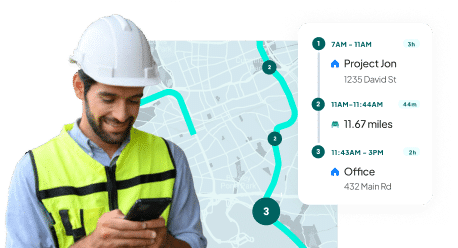
What Are Toolbox Talk Templates?
Toolbox talk templates are pre-designed forms that make it easy to organize and deliver workplace safety discussions. These templates provide a clear structure for supervisors to address hazards, review safety protocols, and promote awareness among their teams.
They help ensure safety talks are consistent, focused, and aligned with workplace safety standards.
Functions:
- Provide a ready-made layout for specific safety topics.
- Guide supervisors through key points, including hazards, preventive measures, and emergency responses.
- Document safety discussions for compliance and future reference.
Benefits:
- Save time by eliminating the need to create safety discussions from scratch.
- Ensure all safety talks cover essential points, creating a standard for consistency.
- Increase team engagement with clear and organized presentations.
Limitations:
- May feel repetitive if not tailored to current tasks or hazards.
- Require customization to fit unique job site conditions.
Good Examples of Toolbox Talk Template Use
When used effectively, toolbox talk templates can significantly enhance workplace safety. Here are some practical and impactful ways to utilize these templates to foster a culture of safety and awareness.
-
Pre-Task Safety Discussions: Use the Ladder Safety Toolbox Talk before jobs involving ladder use to remind workers of proper setup, positioning, and weight limits, ensuring tasks are completed without incident.
-
Addressing Seasonal Hazards: Conduct a session with the Rainy Weather Toolbox Talk to prepare teams for wet conditions, emphasizing non-slip footwear, waterproof gear, and increased caution.
-
Reinforcing PPE Usage: Use the PPE Toolbox Talk to educate new employees on proper gear requirements or to refresh the knowledge of seasoned workers, ensuring compliance with safety protocols.
-
Preventing Workplace Injuries: Schedule the Hand Safety Toolbox Talk to discuss injury prevention strategies like wearing the right gloves and using tools correctly, reducing common hand-related injuries.
-
Responding to Site Risks: When incidents like slips or near misses occur, use the Slips, Trips, and Falls Toolbox Talk to address hazards and reinforce best practices for maintaining clean and safe work areas.
-
Compliance with Safety Regulations: Deliver the Electrical Safety Toolbox Talk to educate workers about lockout/tagout procedures and safe handling of electrical equipment, ensuring compliance with OSHA standards.
-
High-Risk Tasks Preparation: Use the Fall Protection Toolbox Talk before projects requiring harnesses or scaffolding to ensure workers understand proper equipment use and anchoring techniques.
Bad Examples of Toolbox Talk Template Use
Improper use of toolbox talk templates can undermine their effectiveness, leading to missed safety opportunities and reduced engagement. Here are some examples of poor practices to avoid when using these templates.
-
Rushing Through the Talk: Conducting a PPE Toolbox Talk without explaining why specific gear is required or how to use it correctly can result in workers overlooking its importance.
-
Ignoring Relevance: Using the Rainy Weather Toolbox Talk on a clear, sunny day fails to address current workplace hazards, leading to disengaged workers.
-
Skipping Key Details: Delivering a Ladder Safety Toolbox Talk without discussing inspection requirements or proper positioning reduces its impact and leaves critical risks unaddressed.
-
Overloading the Talk with Information: Combining the Electrical Safety Toolbox Talk with unrelated topics can overwhelm workers, making it harder for them to retain vital safety information.
-
Inconsistent Use: Failing to hold regular talks with templates like the Slips, Trips, and Falls Toolbox Talk can lead to lapses in awareness and preventable accidents.
-
Not Encouraging Participation: Reading directly from the Hand Safety Toolbox Talk without engaging the team or inviting questions limits its effectiveness as a discussion tool.
-
Failing to Follow Up: Using the Fall Protection Toolbox Talk but not ensuring workers inspect their equipment afterward misses the opportunity to apply safety practices in real time.
A Step-By-Step Guide to Using Toolbox Talk Templates
Toolbox talk templates are an effective way to ensure safety discussions are organized, relevant, and impactful. Follow this simple guide to make the most out of your toolbox talk templates.
Step 1: Select the Right Toolbox Talk Template
Choose a template that fits the specific risks or tasks your team will face on the job site.
Use Case Examples:
- Use the Ladder Safety Toolbox Talk for tasks involving ladder use.
- Select the Rainy Weather Toolbox Talk when working outdoors in wet conditions.
Action: Pick a template that matches your job site’s hazards or the day’s tasks.
Step 2: Prepare the Template Before the Talk
Fill out the template with relevant job site details, such as specific hazards or safety protocols.
Use Case Examples:
- Add site-specific risks to the Slips, Trips, and Falls Toolbox Talk to make it relevant to the work area.
- Highlight key PPE requirements in the PPE Toolbox Talk to match the day’s tasks.
Action: Customize the template to align with current conditions and crew needs.
Step 3: Deliver the Talk Effectively
Present the toolbox talk in a way that engages your crew and ensures the message is clear. Use real-world examples to make the discussion relatable.
Use Case Examples:
- Demonstrate proper ladder setup while delivering the Ladder Safety Toolbox Talk.
- Use the Hand Safety Toolbox Talk to show how to wear gloves properly and handle tools safely.
Action: Make the talk interactive by encouraging questions and discussions.
Step 4: Encourage Worker Feedback
Invite your team to share their experiences, concerns, or suggestions about the topic being discussed.
Use Case Examples:
- Ask crew members about challenges they’ve faced with wet conditions during the Rainy Weather Toolbox Talk.
- Gather feedback on equipment conditions during the Fall Protection Toolbox Talk.
Action: Create an open dialogue to make the talk more engaging and actionable.
Step 5: Document the Toolbox Talk
Keep records of the discussions, including attendance and topics covered, to show compliance with safety regulations.
Use Case Examples:
- Use the Electrical Safety Toolbox Talk log to track workers trained on lockout/tagout procedures.
- Record attendance for the Slips, Trips, and Falls Toolbox Talk as part of your safety documentation.
Action: Save completed templates and attendance records for audits or inspections.
Step 6: Follow Up With Practical Steps
After the talk, ensure that the discussed practices are implemented on-site. Reinforce key points through follow-ups or checks.
Use Case Examples:
- Conduct equipment checks after delivering the Fall Protection Toolbox Talk.
- Provide non-slip footwear after the Rainy Weather Toolbox Talk.
Action: Monitor your team’s adherence to safety practices and address any gaps.
Your Next Steps With Toolbox Talk Templates
Toolbox talk templates are great for improving workplace safety and fostering better communication on-site. But to run your projects smoothly, you need more than just safety tools. Here are other templates that can help streamline your operations and keep your team on track:
Step 1: Plan Work Schedules With Employee Schedule Templates
An Employee Schedule Template helps you organize shifts, assign tasks, and ensure your crew is where they need to be. This keeps projects running efficiently and eliminates confusion about work hours.
Next Step: Combine your toolbox talks with clear schedules to make sure every worker is ready for the day.
Step 2: Track Progress With Punch List Templates
Use Punch List Templates to stay on top of incomplete tasks and prioritize work. These templates help you ensure all jobs are finished to standard and on time.
Next Step: Include punch lists in your workflow to track the completion of tasks and address safety concerns from toolbox talks.
Step 3: Manage Employee Performance With Employee Write-Up Templates
The Employee Write-Up Template provides a clear way to document performance issues and foster accountability. It’s a simple tool for keeping your crew on track and improving communication.
Next Step: Pair employee write-ups with toolbox talks to address performance and safety issues constructively.
Try Toolbox Talk Templates in Workyard!
While templates are a great start, tools like Workyard can enhance your safety efforts with features like real-time tracking, digital logs, and centralized records. Workyard ensures all toolbox talks are documented and accessible for audits or safety planning.
Try Workyard free for 14 days to see how it complements your safety initiatives and integrates with your team’s workflow.
Looking for an easier way to manage construction business data? Try the Workyard app!
See how it works

